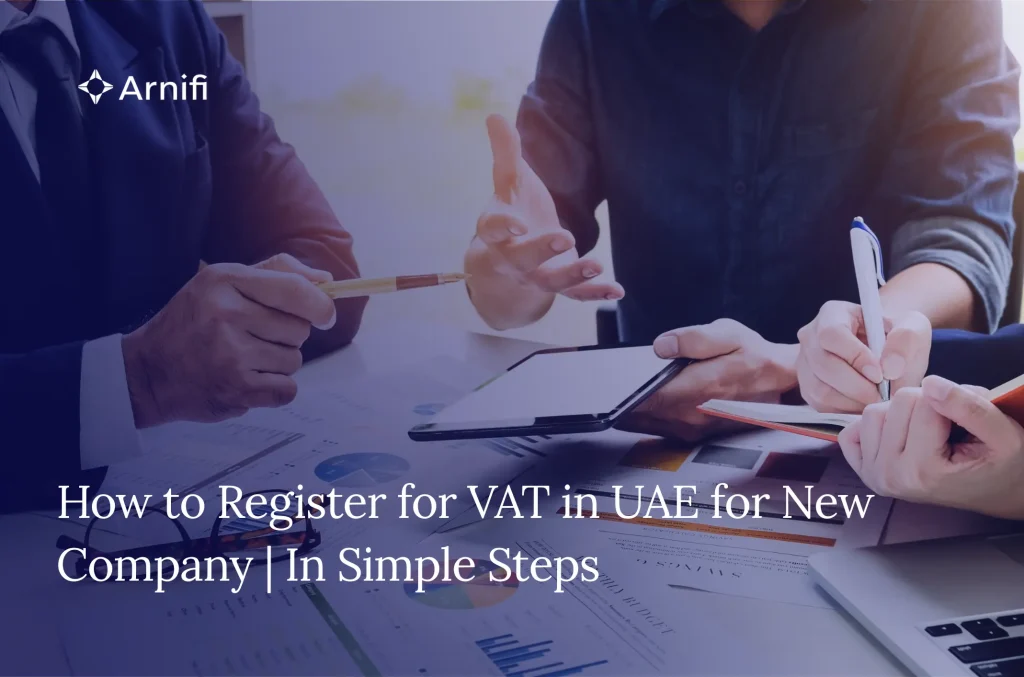How to Register for VAT in UAE for New Company in Simple Steps
by
Shethana
Nov 19, 2025  9 MIN READ
9 MIN READ

Registering for Value Added Tax (VAT) is a foundational step for new entities trading goods or services in the UAE. The question most finance teams begin with is how to register for VAT in UAE for new company, and the answer is more than just the simple registration process.
Table of contents
- Who Must Register for VAT in UAE?
- Documents Required for VAT Registration in UAE
- How to Register for VAT in UAE Through the EmaraTax Portal?
- Steps for First-period Compliance
- Zero-rated or Exempt Supplies
- How to Do Filing and Payment?
- Common mistakes and how to prevent them
- What are the Timelines and Cost to Register for VAT in UAE?
- How to Manage After Registration of a New Company in UAE?
- How Arnifi Helps Maintain a Clean Business Profile?
- FAQs
Threshold tests, evidence of taxable activity, group considerations, invoice rules, and post-registration controls all sit inside the same workflow.
This guide sets out a practical, end-to-end path that senior leaders and accountants can follow to achieve a clean Tax Registration Number (TRN). Also, it’ll help businesses maintain compliant records for periodic returns and reviews.
Who Must Register for VAT in UAE?
VAT in UAE refers to the federal framework that took effect in 2018 and is administered by the Federal Tax Authority. The system is destination-based, applies at standard and zero rates depending on the supply, and expects accurate books that reconcile to bank activity, customs records, and management reports.
Mandatory registration
A resident taxable person must register when taxable supplies and imports over the last 12 months exceed AED 375,000 or are expected to exceed that figure in the next 30 days.
Non-residents making taxable supplies in the Emirates must register if the tax is not accounted for under reverse charge by a UAE recipient.
Voluntary registration
A business may register voluntarily when taxable supplies or taxable expenses cross AED 187,500. Firms expecting near-term revenue and wishing to recover input tax on set-up costs often select this route.
VAT group registration
Entities under common control can apply to register as a group if legal and control conditions are met. Grouping can simplify return preparation, eliminate VAT on intra-group supplies, and centralise compliance, but it also concentrates responsibility for errors.
Documents Required for VAT Registration in UAE
Strong applications move faster because the facts are clear. Finance teams typically prepare the following before logging into EmaraTax:
- Legal facts. Trade licence, articles, establishment cards, branch details, and ownership percentages.
- Authorised signatory. Passport, Emirates ID, and a board resolution or power of attorney.
- Bank evidence. A bank account validation letter in the legal entity’s name.
- Commercial activity proof. Contracts, invoices, import records, or other documents showing taxable business activity.
- Threshold workings. Rolling 12-month calculations for supplies and imports, plus a 30-day forward look that supports any mandatory registration claim.
- Systems. A chart of accounts, tax codes, and invoice templates aligned to UAE rules, ready to activate on TRN issuance.
How to Register for VAT in UAE Through the EmaraTax Portal?
Most VAT registrations in UAE are completed on the FTA’s EmaraTax portal. The on-screen sequence is straightforward when data is prepared in advance.
- Create an account and complete a profile. Identify the legal person, branches, and contact channels.
- Start VAT registration. Select resident or non-resident status, indicate establishment location, and declare expected supplies.
- Enter financial details. Provide turnover for past 12 months, anticipated 30-day supplies if claiming mandatory registration, and breakdowns by activity if requested.
- Attach evidence. Upload corporate documents, signatory ID, bank letter, and threshold workings. Where e-commerce or importing is core, attach samples of contracts or customs statements.
- Declare, review, and submit. Ensure names, dates, and numbers match uploaded papers.
- FTA review and TRN. Respond to any clarification prompts. After approval, a TRN is released and appears in the taxpayer account.
Important Advice: Once the TRN is active, invoicing must reflect the required fields, and accounting systems must apply correct tax codes to sales and purchases. Assign return periods as allocated by the FTA and prepare payment rails in advance to avoid deadline friction.
If it’s confusing to follow, hire expert accounting and bookkeeping services that take care of everything, from VAT registration process to managing a clean profile of the business.
Steps for First-period Compliance
Configure invoicing
Tax invoices require the supplier’s name, address, TRN, a unique sequential number, date of issue, description, consideration, VAT amount, and exchange rate if issued in foreign currency. Simplified invoices are permitted in defined cases but should still contain specific fields.
Set tax codes and mapping
Use clear codes for standard-rated, zero-rated, exempt, reverse-charge, and out-of-scope transactions. Configure purchase codes to record import VAT and reverse charge on services.
Reconcile by box
Control accounts should tie to the VAT return format. Sales by rate, purchases by treatment, imports, and adjustments should roll into the exact boxes, making audit trails simple.
Evidence discipline
Retain contracts, delivery notes, customs forms, and bank proof. Keep a single location for supporting files linked to each transaction. Consistent naming and indexing save time during reviews.
Zero-rated or Exempt Supplies
Clarity on reliefs reduces risk. Zero-rated supplies can still allow input recovery, while exempt supplies do not.
Zero-rated examples
Exports of goods and services meeting conditions, certain international transport, specified education and health supplies, and first supply of residential buildings within defined periods.
Exempt examples
Certain financial services, local passenger transport, supply of bare land, and subsequent supplies of residential property beyond the first supply.
Easy to understand now, right? However, here’s a short reference:
UAE VAT exemptions helps teams keep consistency in SOPs and avoids mixing zero and exempt logic when preparing returns.
How to Do Filing and Payment?
The phrase VAT filing in UAE covers the recurring cycle of return preparation, submission, and settlement. Many registrants are assigned quarterly periods, while sectors with higher volumes may file monthly.
Returns and payments are generally due within 28 days from the end of the tax period. Key disciplines include:
- Timely closes. Lock ledgers and freeze adjustments for the finished period.
- Import and reverse-charge checks. Confirm that customs data and supplier self-accounting entries tie to return boxes.
- Credit note handling. Ensure reductions follow invoice and goods-return rules, and disclosure matches the period of issue.
- Voluntary disclosures. Use the official mechanism to correct material errors in closed periods and keep a clear trail of reasons and calculations.
Important advice from Arnifi: Late filings and payments can lead to administrative penalties that add up quickly, so calendar prompts and segregated responsibility for preparation and approval are useful controls. For expert consultation, visit our website.
Common mistakes and how to prevent them
- Threshold miscalculation. Teams sometimes exclude zero-rated supplies or reverse-charge imports from the rolling 12-month test. Maintain a monthly threshold worksheet that mirrors the FTA definition to support decisions.
- Wrong place of supply. Services delivered to overseas customers may still be taxable in the Emirates depending on the scenario. A written matrix per activity reduces case-by-case confusion.
- Invoice defects. Missing TRN, incorrect descriptions, or foreign currency conversions without stated exchange rates can force re-work. Use system templates and checklists.
- Inconsistent tax codes. Multiple staff using ad-hoc codes generate messy ledgers. Restrict code creation and review mappings each quarter.
- Loose evidence. Scattered documents slow audits and refunds. Store attachments by period and link them to ledger entries.
- Ignoring reverse charge. Imported services without reverse-charge recognition distort both output and input tax. Automate the journal and reconcile monthly.
What are the Timelines and Cost to Register for VAT in UAE?
Application fee
At the time of writing, VAT registration on EmaraTax does not attract an FTA fee, though professional handling and translation costs vary.
Review timelines
Straightforward applications can be approved quickly, while cases with incomplete evidence, complex shareholding, or non-resident status may require clarifications that extend the timeline.
Operating model choices
Internal finance teams often retain oversight and approvals while outsourcing routine bookkeeping, reconciliations, and return preparation to a specialist partner. Clear roles and SLA-based workflows prevent gaps.
How to Manage After Registration of a New Company in UAE?
- Chart governance. Lock account creation, maintain naming standards, and assign tax codes deliberately.
- Monthly reconciliations. Bank, receivables, payables, import VAT, and output tax should reconcile to control accounts.
- Management reviews. Quarterly reviews of zero-rated evidence, exempt classifications, and reverse-charge entries catch issues early.
- Training. Procurement and sales teams should understand invoice and document rules so mistakes do not enter the ledger in the first place.
- Refunds and offsets. Where input exceeds output, refund claims can be considered if the evidence is strong. Otherwise, credits carry forward against the next period.
How Arnifi Helps Maintain a Clean Business Profile?
Arnifi handles VAT threshold reviews, EmaraTax applications, and post-registration routines for periodic returns, audits, and refunds. Teams configure tax codes and invoice templates, reconcile imports and reverse charge, and maintain audit-ready files linked to ledger entries.
The objective is predictable compliance with fewer surprises and a stable base for corporate tax and other regulatory reporting. Hire VAT registration services from Arnifi to stay stress-free.
FAQs
1) What is included in taxable supplies for the threshold test
Standard-rated and zero-rated domestic supplies, imports, and reverse-charge entries count toward the threshold. Exempt supplies do not.
2) Can a pre-revenue company register voluntarily
Yes, if taxable expenses or taxable supplies exceed AED 187,500 and evidence supports genuine economic activity.
3) How are branches handled
Branches within the same emirate and licence can be treated as part of the main entity for registration, but the profile must disclose them accurately.
4) What should an invoice show after TRN issuance
Supplier details, TRN, invoice date and number, customer details, description, quantity, consideration, VAT amount, and conversion where relevant. Credit notes must cross-reference the original invoice.
5) How long should records be kept
Records should be retained for the statutory period, including invoices, contracts, customs forms, working papers, and reconciliation schedules.
6) What if errors are found after filing
Use the voluntary disclosure process for material mistakes and keep a full explanation with calculations and approvals.
7) Are exports always zero-rated
Exports of goods and services can be zero-rated when conditions are met. Evidence of export and recipient status is essential.
Top UAE Packages

Related Articles
Top UAE Packages



